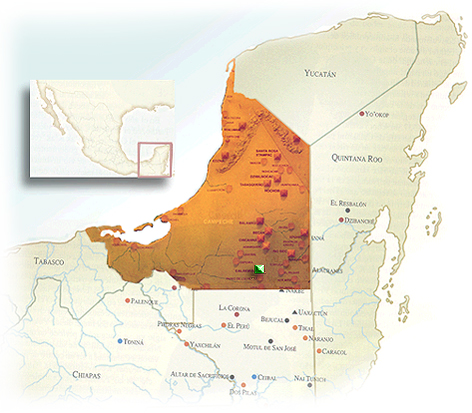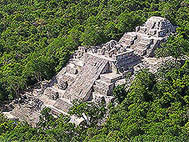


Virtual Calakmul main page
Virtual Calakmul: Interface Technology for World Heritage Preservation
 Calakmul (pronounced kah-lock-MOOL) is an important ancient
Mayan metropolis set deep in the forest of a national reserve in the
Mexican State of Campeche. Although Calakmul was one of the most
powerful Mayan cities, it was discovered by archeologists relatively
recently (1931), and is still being explored. In 2002 Calakmul was
added to UNESCO's list of World Heritage Sites. Because of its
relative isolation, Calakmul and its artifacts are prime candidates for
VR reconstruction for public presentation and
education.
Calakmul (pronounced kah-lock-MOOL) is an important ancient
Mayan metropolis set deep in the forest of a national reserve in the
Mexican State of Campeche. Although Calakmul was one of the most
powerful Mayan cities, it was discovered by archeologists relatively
recently (1931), and is still being explored. In 2002 Calakmul was
added to UNESCO's list of World Heritage Sites. Because of its
relative isolation, Calakmul and its artifacts are prime candidates for
VR reconstruction for public presentation and
education.
The Virtual Calakmul project is developing new tools for making World Heritage sites such as Calakmul more accessible to both the public and he scientific community.
Demonstrations
 Several
works-in-progress illustrate concepts in virtual heritage
preservation:
Several
works-in-progress illustrate concepts in virtual heritage
preservation:
Calakmul Artifacts Magic Book shows high-resolution 3D reconstructions of several artifacts and describes their context within one of the primary structures, a tomb in Structure II.
Calakmul Guided Tour presents a VRML flythrough of the site structures, with building labels and positional triggers for advancing automatically through the site model.
Calakmul Transition Pointer allows the user to transition to an arbitrary egocentric position anywhere within the site model by using an ARToolkit-tracked pointer within the exocentric view.
Calakmul Astronomical Viewpoints shows the relation between various viewpoints within the central (E-Structure) building complex and the movement patterns of the sun and stars.
Calakmul Animal Agents explores the use of naturally-behaving virtual agents based on the indigenous animals of Calakmul (e.g., jaguars and deer).
Research Partners
We have assembled a multi-institutional team of researchers in Mexico and the United States with broad expertise in the areas of human-computer interface, intelligent agents, and virtual architectural design:
Rocio Ruiz Rodarte (Universidad Autónoma Metropolitana, Unidad Azcapotzalco) – Project PI
Jesus Savage Carmona (Intelligent Interfaces Lab, Universidad Nacional Autónoma de México)
Chris Byrne (Cascadia College, Bothell)
Colin Sprague (Computational Linguistics, University of Chicago)
The research team also works closely with the chief archeologist at Calakmul (Ramon Carrasco) and with the Mexican National Institute of Anthropology and History (INAH).
Contacts
Suzanne Weghorst <weghorst![]() u.washington.edu>
u.washington.edu>